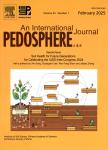Biofumigation effects of brassicaceous cover crops on soil health in cucurbit agroecosystems in Hawaii, USA
Biofumigation effects of brassicaceous cover crops on soil health in cucurbit agroecosystems in Hawaii, USA作者机构:Department of Plant and Environmental Protection SciencesUniversity of Hawaii at ManoaHI 96822USA Department of AgriculturePapua New Guinea University of TechnologyLae 411Papua New Guinea University of California Agriculture and Natural Resources DivisionCooperative ExtensionIndio CA 92201USA
出 版 物:《Pedosphere》 (土壤圈(英文版))
年 卷 期:2022年第32卷第4期
页 面:521-531页
核心收录:
基 金:funded in part by the University of Hawaii College of Tropical Agriculture and Human Resources(Nos.9034R,9048H,and POW 16-964) the Natural Resources Conservation Services-Conservation Innovation Grants(Nos.NR 1892510002G004 and 69-9251-15-957) the Western Sustainable Agriculture Research and E-ducation Graduate Student Grant(No.GW 18-026)of USA
主 题:brown mustard free-living nematode glucose oil radish plant-parasitic nematode soil-borne pathogens sulfate
摘 要:Brassicaceous cover crops, such as brown mustard (Brassica juncea) and oil radish (Raphanus sativus), are commonly used for biofumigation, a process that utilizes isothiocyanates (ITCs) generated from the hydrolysis of glucosinolates in Brassica plants to suppress soil-borne pathogens, including plant-parasitic nematodes. Given the biocidal nature of ITCs, limited information is available on the non-target effects of biofumigation on free-living nematodes, which are reliable soil health indicators. The objectives of this study were to determine if biofumigation methods effective against plant-parasitic nematodes would have non-target effects on free-living nematodes, and to examine the relationships between biofumigation indicators and nematode communities. Three field trials were conducted to examine whether different biofumigation methods would affect free-living nematodes. Tissue maceration of biofumigant crops, soil tillage, and black plastic mulching were adopted singly or in combination to generate different regimes of biofumigation efficacy. Termination of biofumigant crops by tissue maceration and soil tillage followed by black plastic mulching for one week was most effective in suppressing plant-parasitic nematodes and enhancing bacterial decomposition. However, these effects did not last through the subsequent zucchini (Cucurbita pepo) crop cycle. When comparing changes in soil glucose and sulfate concentrations as indicators of biofumigation efficacy, we found that soil sulfate was a better indicator of biofumigation efficacy than soil glucose, owing to the more stable state of sulfate in soil. Canonical correspondence analysis between soil sulfate as a biofumigation indicator and nematode soil health indicators revealed strong positive correlations of sulfate level with the abundances of bacterivorous and carnivorous nematodes, enrichment index, brown mustard biomass, and soil temperature. However, biofumigation did not affect the nematode community stru




